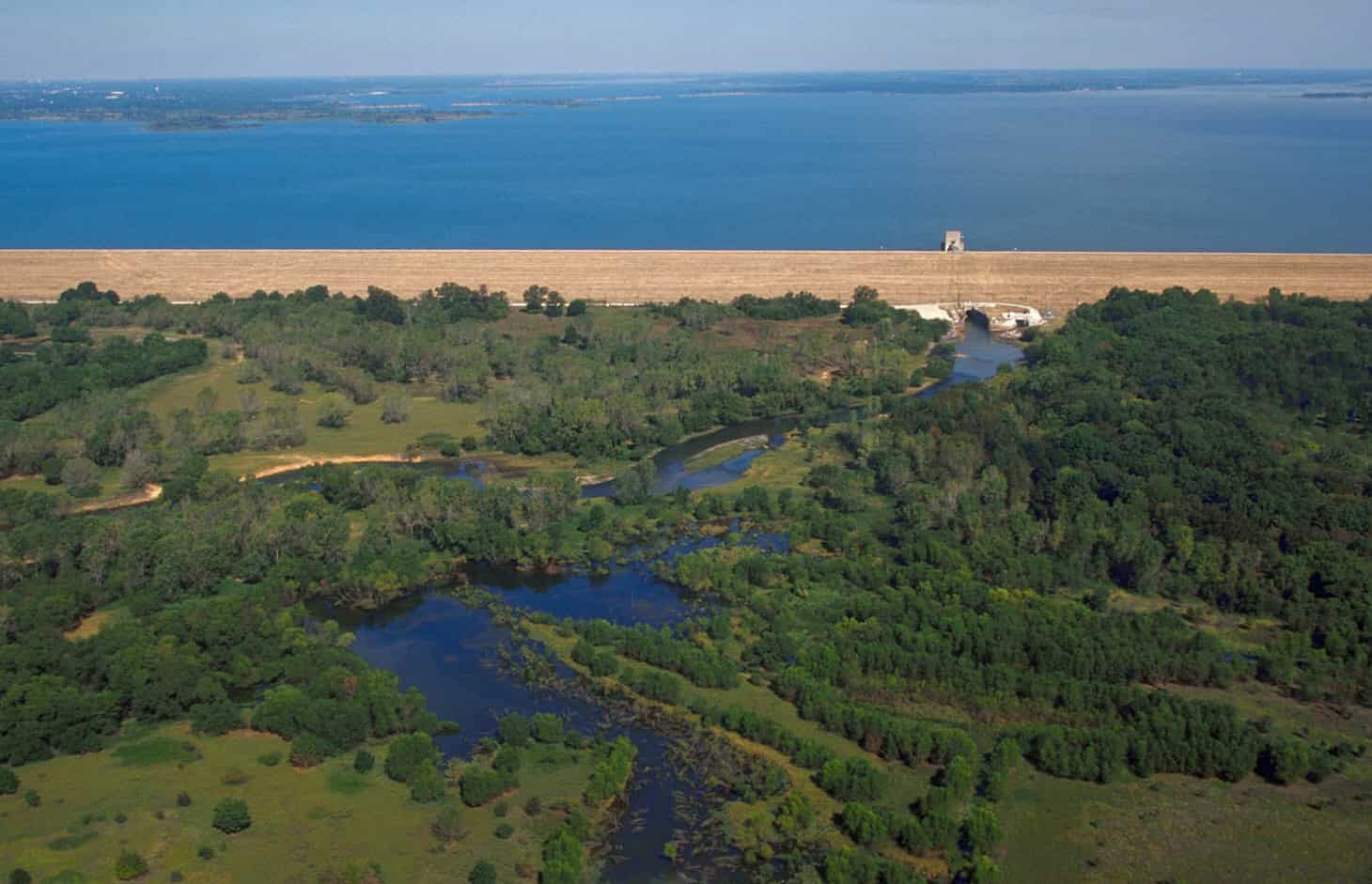Nestled in the heart of Texas, north of Dallas and Fort Worth, Lewisville Lake beckons nature enthusiasts with its breathtaking beauty and many outdoor activities. This reservoir was formed to provide flood control and an increased water supply capacity. The lake offers a haven for boating, fishing, swimming, and camping, just a few of the many activities one can enjoy here. Its serene waters are home to various fish species, including largemouth bass, white bass, and catfish, enticing anglers of all levels. The surrounding landscapes showcase diverse geology, ranging from sedimentary rock formations to river-carved valleys. With connected state parks, nature preserves, and campgrounds, Lewisville Lake invites visitors to explore its natural wonders, creating cherished memories amidst the splendor of Texas’ great outdoors.
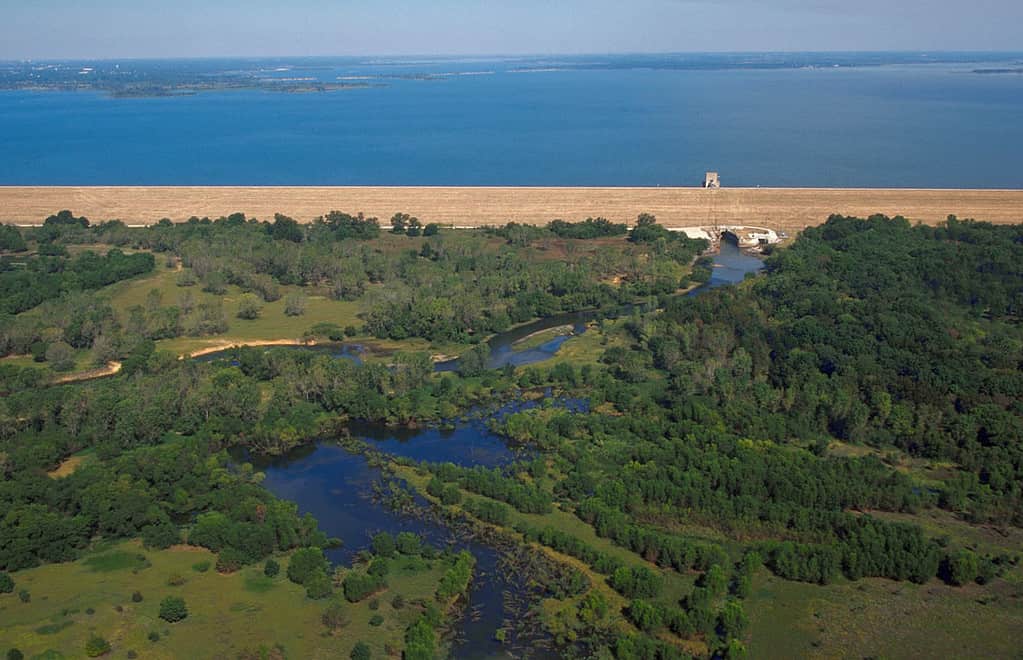
Lewisville Lake is a man-made reservoir in Texas just north of Dallas.
©U.S. Army Corps of Engineers, photographer not specified or unknown, Public domain, via Wikimedia Commons / – Original / License
Location
You can find Lewisville Lake situated in the state of Texas, north of Fort Worth and Dallas. This picturesque reservoir spans four different counties, namely Denton, Dallas, Collin, and Tarrant.
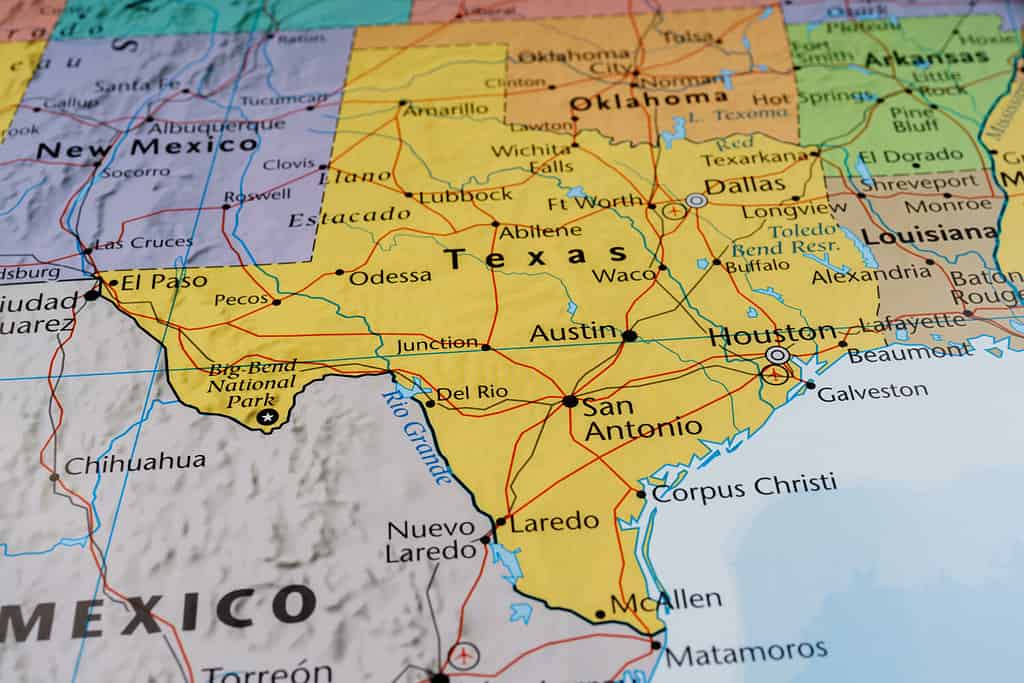
Lewisville Lake is a popular recreation spot for locals.
©Alexander Lukatskiy/Shutterstock.com
History
Lewisville Lake’s history began in the 1940s when it became apparent that there was a need for flood control and an increased water supply in the rapidly growing Dallas-Fort Worth metropolitan area. In 1948 the U.S. Army Corps of Engineers began construction on the Garza-Little Elm Dam. This effort combined Lake Dallas, Hickory Creek, and Little Elm Creek. They completed construction in 1954. Shortly after, they completed construction on the Lewisville Dam in 1955. Proceeding with the completion of both dams, the Garza Dam, not to be confused with the Garza-Little Elm Dam, was breached in 1957 to create the Garza-Little Elm Reservoir. After much confusion and debate, they renamed the reservoir Lewisville Lake in the mid-1970s.
The creation of Lewisville Lake required the formation of the Elm Fork of the Trinity River. The reservoir, spanning approximately 29,592 acres at full capacity, was designed to provide flood control measures, store water for municipal and industrial use, and offer recreational opportunities to the local communities.
Over the years, Lewisville Lake has played a crucial role in mitigating the impact of flooding in the Trinity River Basin. The reservoir’s capacity to hold excess water during heavy rain events has provided significant protection to downstream areas. Additionally, the stored water has served as a vital resource for water supply, supporting the needs of residents, industries, and agricultural activities.
Recent History
In the past 15 years, the dam has experienced issues with crumbling. It has struggled to maintain its capacity and has narrowly avoided failure on numerous occasions. In 2017 the U.S. Army Corps of Engineers approved a repair and upgrade project. Parts of the repair project were completed in 2021, while other aspects of repair are still ongoing.
Today, Lewisville Lake exemplifies the coexistence between humans and nature. The lake continues to be a vital water resource, a recreational destination for locals and visitors, and a wildlife sanctuary. Efforts are ongoing to ensure the preservation and responsible management of Lewisville Lake, safeguarding its ecological integrity for future generations to enjoy.
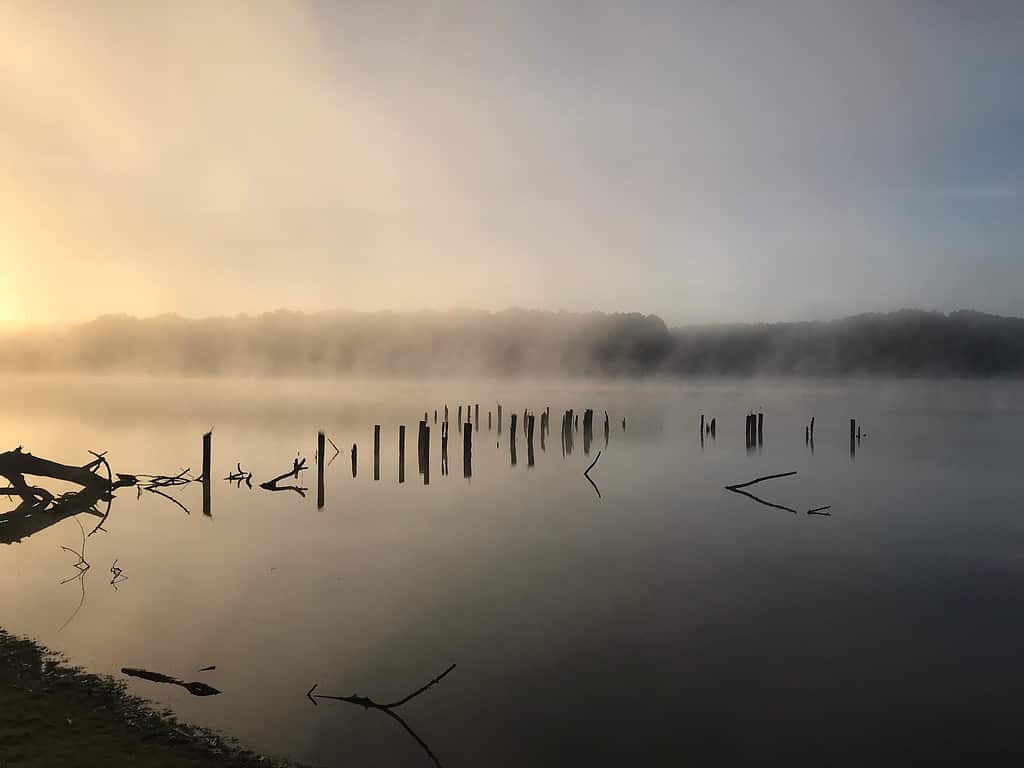
Lewisville Lake was created need due to the need for flood control and an increased water supply.
©Sterling Studios/Shutterstock.com
Size
Lewisville Lake showcases its impressive size. With its vast waters, this reservoir is a true testament to the power and beauty of nature. When at its full capacity, Lewisville Lake spans an expansive surface area.
The surface area of Lewisville Lake reaches an astounding size, with a surface area of approximately 29,592 acres. This vast expanse of water provides ample space for various recreational activities. It also ensures a reliable water supply for the surrounding communities. Moreover, Lewisville Lake has approximately 183 miles of shoreline.
Lewisville Lake stretches wide, with a width of approximately 4.24 miles. This expansive width allows for picturesque vistas and creates a sense of openness as the lake extends toward the horizon.
In addition to its impressive width, Lewisville Lake extends long, showcasing its remarkable length. The lake stretches 11 miles, providing ample room for boating, fishing, and other recreational pursuits. This significant length allows visitors to embark on journeys of exploration, soak in the breathtaking views, and experience the tranquility that the lake has to offer.
Depth
The depth of Lewisville Lake reaches considerable levels, providing a glimpse into the hidden world beneath its surface. On average, the maximum depth of the lake is roughly 67 feet. These depths offer a diverse underwater landscape, creating habitats for various fish species and captivating the curiosity of divers and nature enthusiasts.
Throughout the year, the lake’s temperature experiences fluctuations, reflecting the changing seasons of Texas. During the hot summer months, the lake’s surface temperature can reach 75 to 85 degrees Fahrenheit, inviting visitors to cool off and enjoy water-based activities. In contrast, during the colder winter months, the lake’s surface temperature may dip to roughly 40 degrees Fahrenheit, adding a touch of crispness to the air. These temperature variations contribute to the dynamic nature of the lake and cater to different preferences throughout the year.
Regarding wave size, Lewisville Lake generally experiences calm to moderate conditions. The size of waves largely depends on various factors, including wind speed and direction. During periods of strong winds, the lake can occasionally witness larger waves. However, it is important to note that Lewisville Lake is not typically known for extreme wave activity.
Water Level
The water level of Lewisville Lake ranges from approximately 521 feet to 529 feet above mean sea level (MSL).
The water capacity, or storage capacity, of Lewisville Lake in Texas, was approximately 436,000 acre-feet upon its creation in 1957. After they made additional modifications in 1988 to increase the holding capacity permanently, the lake now has a holding capacity of roughly 555,000 acre-feet. This measurement represents the total volume of water the reservoir can hold at its maximum level, also known as the full pool level. The storage capacity of Lewisville Lake is a crucial aspect of its function, as it provides a reliable water supply for residential, industrial, and agricultural needs while also helping to mitigate flood risks in the Trinity River Basin.
Throughout the year, the water level of Lewisville Lake experiences fluctuations in response to rainfall, evaporation, and water release activities. Rainfall plays a significant role in replenishing the lake, as precipitation contributes to its water supply. During periods of abundant rainfall, the lake’s water level rises, offering a larger expanse of water for recreational activities and ensuring a stable water supply for the surrounding communities.
Conversely, evaporation contributes to gradually reducing the lake’s water level. The hot Texas climate and exposure to sunlight cause the water to evaporate, decreasing the lake’s water volume progressively. Additionally, water releases conducted by the U.S. Army Corps of Engineers for flood control purposes can also impact the water level of Lewisville Lake.
Monitoring agencies, such as the U.S. Army Corps of Engineers, regularly assess and report the water levels of Lewisville Lake to ensure effective water management and support flood control efforts while maintaining a sustainable water supply.
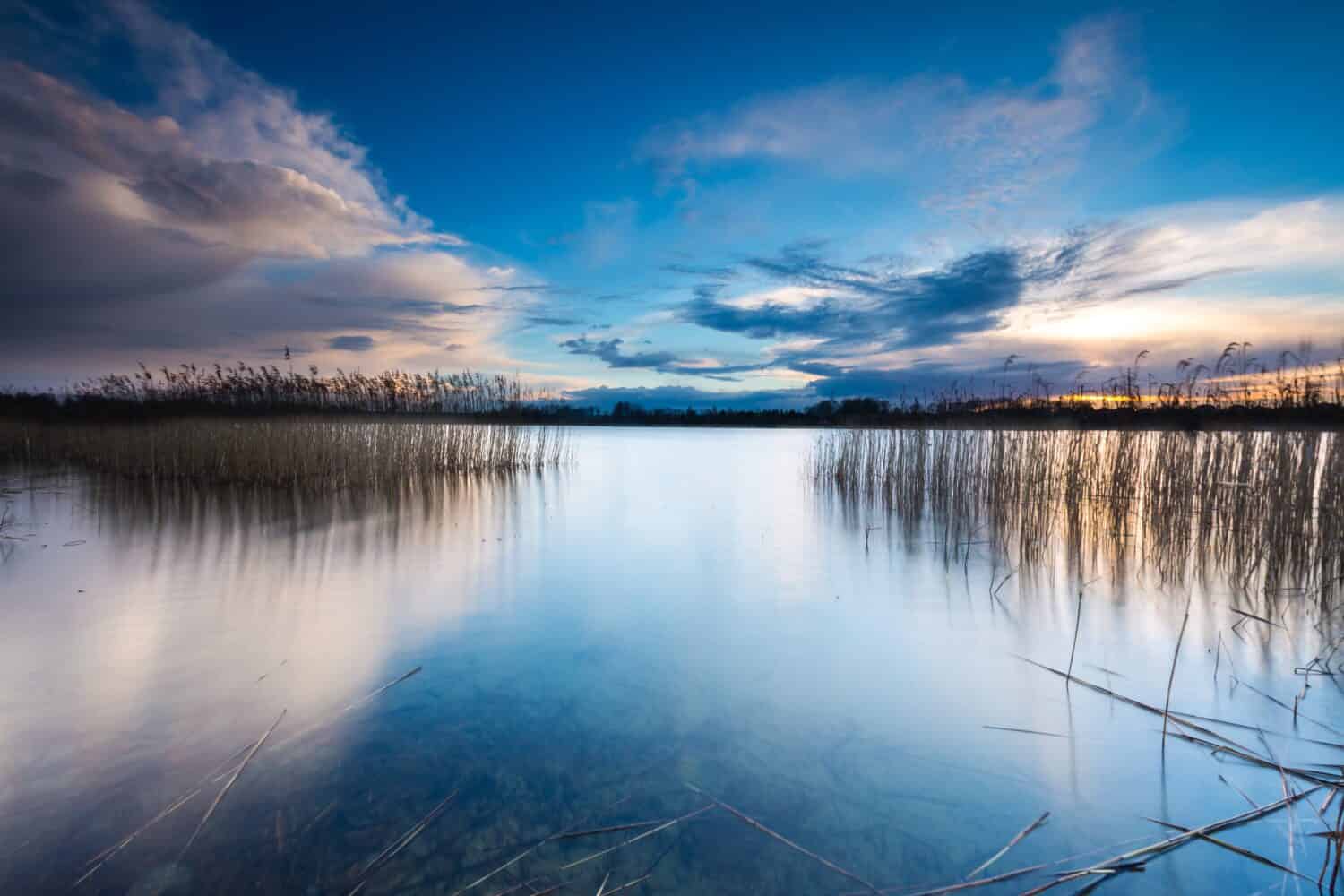
Lewisville Lake is roughly 67 feet at its deepest.
©Greens and Blues/Shutterstock.com
Fishing
Lewisville Lake is renowned for its abundant fish population, providing anglers with thrilling opportunities to hook various species. Among the most common fish in the lake are largemouth bass, white bass, hybrid striped bass, catfish (including blue catfish and channel catfish), and crappie. These sought-after fish species attract experienced anglers and novices eager to test their fishing skills.
Lewisville Lake adheres to specific fishing rules and regulations to ensure the sustainability and preservation of the fish population. Anglers must obtain a valid fishing license issued by the Texas Parks and Wildlife Department (TPWD). The TPWD also establishes guidelines regarding bag limits, size limits, and specific fishing seasons for different fish species in the lake. Adhering to these regulations helps maintain a healthy fish population and ensures a balanced ecosystem.
Anglers need to stay informed about any updates or changes in fishing rules and regulations. As well as any specific guidelines related to fishing seasons, catch limits, and size restrictions. The TPWD website provides up-to-date information on fishing regulations, license requirements, and the latest fishing reports for Lewisville Lake.
Largemouth Bass
Largemouth bass are prized game fish known for their spirited fights and impressive size. They possess a distinctive, elongated body with a large mouth, and their coloring can range from green to olive brown with a dark lateral line. You can spot Largemouth bass throughout the year in Lewisville Lake. However, the prime fishing seasons are typically in spring and fall. During these seasons, bass becomes more active and moves to shallower waters, offering exciting angling opportunities.
White Bass
White bass, also known as sand bass, are renowned for their feisty nature and schooling behavior. They have a silvery-white body with dark horizontal stripes running along their sides. White bass often migrates and spawn in large numbers during late winter and early spring, making it an ideal time to target them. Anglers can expect an action-packed fishing experience during these spawning runs as the fish gather in shallower areas, chasing baitfish and providing thrilling catches.
Hybrid Striped Bass
Hybrid striped bass, commonly called hybrid bass or simply hybrids, are a cross between white bass and striped bass. They possess a sleek, streamlined body with vertical stripes and silvery coloration. Hybrid striped bass thrives in Lewisville Lake, providing anglers with a thrilling fishing experience. The prime fishing season for hybrids is during spring and fall, when they actively feed and congregate near points, humps, and submerged structures.
Catfish
Lewisville Lake offers excellent angling opportunities for catfish, including blue catfish and channel catfish. Blue catfish are large and have robust fighting abilities. They have a bluish-gray body, a forked tail, and distinctive whiskers called barbels. On the other hand, Channel catfish have a more slender body, a deeply forked tail, and smooth skin. You can fish for both species year-round, with catfish often found near structures, river channels, and deep holes. Fishing for catfish can be particularly rewarding during the warmer months of spring and summer.
Crappie
Crappies are popular panfish in Lewisville Lake, sought after for their delicious meat and the challenge they present to anglers. You can find two species of crappie in the lake: black crappie and white crappie. Black crappies have a darker, mottled body with distinct black spots, while white crappies have a lighter body with vertical bars. Crappies tend to move to shallower areas during the cooler months of winter, making it an opportune time for anglers to target them.

A common fish in Lewisville Lake is the Largemouth bass.
©Pierre Rebollar/Shutterstock.com
Geology
The geology surrounding Lewisville Lake, situated within the Trinity River Basin, showcases diverse natural and man-made features that have shaped the region over millions of years. From ancient sedimentary formations to the impact of human engineering, the geology of the Lewisville Lake area tells a captivating story of both natural and anthropogenic influences.
The Lewisville Lake area is underlain by sedimentary rocks deposited and compacted over time through natural processes. These formations, including sandstone, shale, limestone, and siltstone, provide insights into the region’s ancient environments and geological history.
Human Intervention
However, over the past couple of centuries, human intervention has significantly altered the geological landscape surrounding Lewisville Lake. It is nestled within the Trinity River Basin and built on the Elm Fork of the Trinity River. This tributary flows into the larger Trinity River system. The U.S. Army Corps of Engineers undertook the ambitious task of constructing the lake to serve multiple purposes, including flood control, water supply, and recreational opportunities for the surrounding communities.
The dam’s construction involved extensive earthwork, including excavation, embankment, and the placement of various materials. These engineering efforts shaped the geology of the immediate area by altering the natural flow of water, sediment deposition, and erosion patterns.
Today, the Lewisville Dam is a prominent feature in the local geology, impacting the surrounding landscape and the dynamics of the Trinity River Basin. The reservoir created by the dam, Lewisville Lake, has become an integral part of the region’s geology, with its vast expanse of water covering approximately 29,592 acres.
While the man-made creation of Lewisville Lake has altered the natural geological processes in the area, the surrounding sedimentary formations and river-related landforms still bear the marks of natural forces and geological history.
Understanding the geology of the Lewisville Lake area requires acknowledging the interplay between natural and anthropogenic influences. It reminds us of the complex relationship between human activity and the environment while emphasizing the importance of responsible stewardship to preserve the geological integrity of the region.
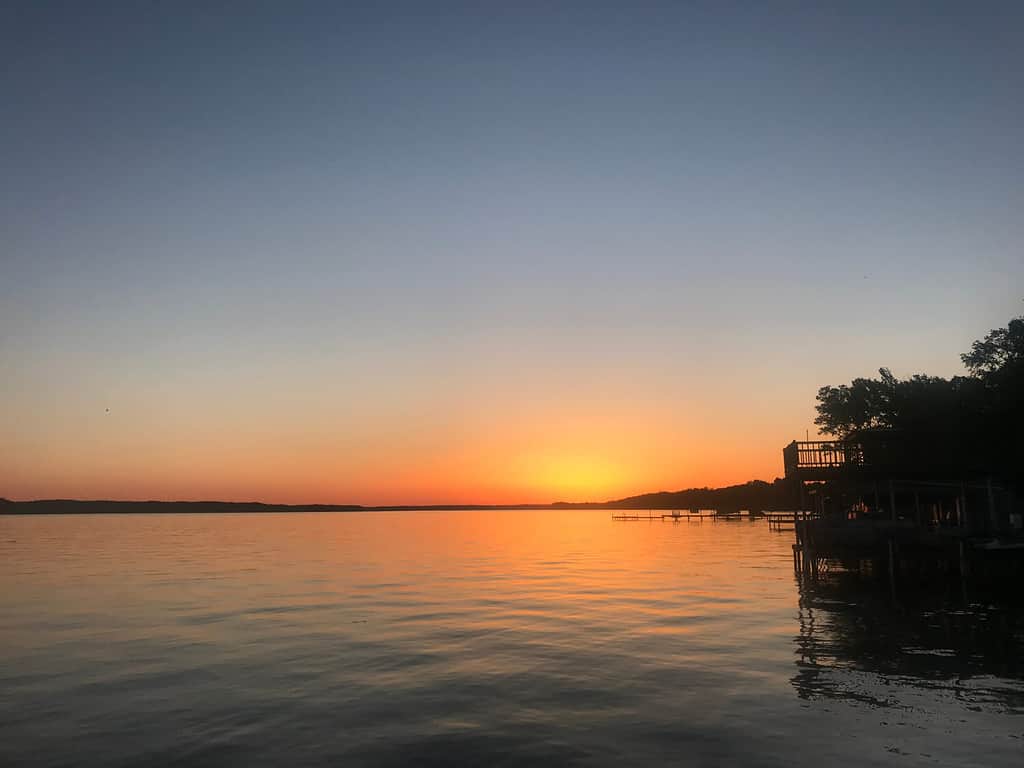
Camping and boating are popular activities on Lewisville Lake.
©Cade Landers/Shutterstock.com
Boating and Other Activities
Boating
This is a favorite pastime at Lewisville Lake, with its vast expanse of water providing ample room for all types of vessels. The lake offers an ideal setting, whether you prefer a leisurely cruise or an adrenaline-filled adventure. Motorboats, sailboats, jet skis, and pontoons dot the sparkling waters as enthusiasts indulge in the pleasures of boating. The lake’s calm and expansive nature make it an inviting destination for those seeking a memorable day on the water.
Swimming
Swimming in the refreshing waters of Lewisville Lake is a delightful way to beat the summer heat. Numerous designated swimming areas ensure a safe and enjoyable experience for visitors of all ages. Whether you prefer a leisurely dip or an invigorating swim, the lake allows everyone to cool off and revel in the natural beauty surrounding them.
Other Activities
Beyond boating and swimming, there are numerous other activities you can enjoy. Some of these include snorkeling, scuba diving, kayaking, and canoeing. As well as enjoying the shoreline parks, event centers, and restaurants, to name a few more options. Lewisville Lake offers a host of other recreational activities throughout the year too. During the winter months, when the temperatures drop, visitors can embrace the seasonal beauty and engage in activities such as birdwatching, hiking, and nature walks. Scenic landscapes surround the lake, making it an ideal spot for those seeking tranquility and connection with nature.
State Parks and Nature Preserves
Lewisville Lake is also connected to several state parks, further enhancing the outdoor experiences available to visitors. The Lewisville Lake Environmental Learning Area (LLELA) is a remarkable nature preserve encompassing over 2,000 acres of pristine habitats, including forests, wetlands, and grasslands. LLELA offers hiking, birdwatching, kayaking, and fishing opportunities, allowing visitors to immerse themselves in the area’s natural wonders.
In addition to LLELA, nearby state parks such as Ray Roberts Lake State Park and Lake Lewisville Park offer additional opportunities for outdoor recreation. Ray Roberts Lake State Park is just a short distance from Lewisville Lake. It features expansive trails for hiking and biking, camping facilities, and fishing and wildlife observation opportunities. You can find Lake Lewisville Park on the shores of Lewisville Lake, which provides picnic areas, swimming beaches, and boat ramps for easy access to the water.
Be Safe and Leave No Trace
It is important to note that visitors to Lewisville Lake should familiarize themselves with safety guidelines and regulations. Boaters should ensure they have the necessary permits and follow boating safety rules to ensure a safe and enjoyable experience. Swimmers should be mindful of designated swimming areas and follow posted guidelines for their safety. Additionally, visitors should respect the natural environment and practice Leave No Trace principles to preserve the beauty of the lake and its surrounding parks.
Camping
Lewisville Lake boasts several campgrounds catering to various preferences and camping styles. Hickory Creek Park, located on the lake’s northern shores, offers campsites equipped with amenities such as picnic tables, fire rings, and restroom facilities. Tower Bay Park, situated on the western shores, provides scenic campsites with access to the lake, perfect for those seeking waterfront camping experiences. Arrowhead Park, nestled on the southern shores, offers a serene camping environment surrounded by nature’s splendor.
The best seasons to camp at Lewisville Lake vary depending on personal preferences and the desired camping experience. Spring and fall are popular seasons for camping, as the weather is mild and comfortable. During these seasons, visitors can enjoy pleasant temperatures, blooming wildflowers, and the tranquility of the lake. Summer camping offers the allure of warm evenings and opportunities for swimming and water activities. However, it may be accompanied by higher temperatures. Winter camping is also possible, providing a peaceful escape amidst cooler temperatures and the chance to experience the serenity of the lake in a different season.
Camping at Lewisville Lake is generally available year-round, providing opportunities for camping enthusiasts to enjoy the beauty of the lake and its surroundings throughout the seasons. However, it is essential to check with the specific campgrounds for any seasonal closures or modifications in services. Some campgrounds may have reduced facilities or limited availability during certain times of the year.
When planning a camping trip to Lewisville Lake, making reservations in advance, particularly during peak seasons and holidays, is advisable to secure a spot at the desired campground. Additionally, familiarize yourself with campground rules and regulations, such as quiet hours, campfire restrictions, and pet policies, to ensure visitors’ pleasant and respectful camping experience.

With its warm waters, Lewisville Lake is a popular lake for swimming.
©l i g h t p o e t/Shutterstock.com
Where is Lewisville Lake Located on a Map?
You can find Lewisville Lake located in North Texas in the United States. It is mainly situated within Denton County, approximately 20 miles north of downtown Dallas. The lake spans across the Elm Fork of the Trinity River, and the cities of Lewisville, Frisco, Little Elm, and The Colony surround it.
Thank you for reading! Have some feedback for us? Contact the AZ Animals editorial team.

